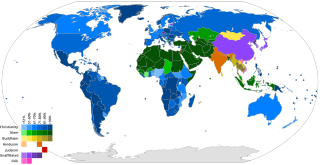Related Research Articles
Christianity began as a movement within Second Temple Judaism, but the two religions gradually diverged over the first few centuries of the Christian Era. Today, differences of opinion vary between denominations in both religions, but the most important distinction is Christian acceptance and Jewish non-acceptance of Jesus as the Messiah prophesied in the Hebrew Bible and Jewish tradition. Early Christianity distinguished itself by determining that observance of halakha was not necessary for non-Jewish converts to Christianity. Another major difference is the two religions' conceptions of God. The Christian God consists of three persons of one essence, with the doctrine of the incarnation of the Son in Jesus being of special importance. Judaism emphasizes the Oneness of God and rejects the Christian concept of God in human form. While Christianity recognizes the Hebrew Bible as part of its scriptural canon, Judaism does not recognize the Christian New Testament.
Millennialism or chiliasm is a belief which is advanced by some religious denominations. According to this belief, a Golden Age will occur or a Paradise will be established on Earth prior to the Last Judgment and the future eternal state of the "world to come".

Predestination, in theology, is the doctrine that all events have been willed by God, usually with reference to the eventual fate of the individual soul. Explanations of predestination often seek to address the paradox of free will, whereby God's omniscience seems incompatible with human free will. In this usage, predestination can be regarded as a form of religious determinism; and usually predeterminism, also known as theological determinism.
Pelagianism is a Christian theological position that holds that the fall did not taint human nature and that humans by divine grace have free will to achieve human perfection. Pelagius, an ascetic and philosopher from the British Isles, taught that God could not command believers to do the impossible, and therefore it must be possible to satisfy all divine commandments. He also taught that it was unjust to punish one person for the sins of another; therefore, infants are born blameless. Pelagius accepted no excuse for sinful behaviour and taught that all Christians, regardless of their station in life, should live unimpeachable, sinless lives.
Religious conversion is the adoption of a set of beliefs identified with one particular religious denomination to the exclusion of others. Thus "religious conversion" would describe the abandoning of adherence to one denomination and affiliating with another. This might be from one to another denomination within the same religion, for example, from Protestant Christianity to Roman Catholicism or from Sunnī Islam to Shīʿa Islam. In some cases, religious conversion "marks a transformation of religious identity and is symbolized by special rituals".

In a religious context, sin is a transgression against divine law or a law of the deities. Each culture has its own interpretation of what it means to commit a sin. While sins are generally considered actions, any thought, word, or act considered immoral, selfish, shameful, harmful, or alienating might be termed "sinful".

Supersessionism, also called replacement theology, is the Christian doctrine that the Christian Church has superseded the nation of Israel assuming their role as God's covenanted people, thus asserting that the New Covenant through Jesus Christ has superseded or replaced the Mosaic covenant. Supersessionists hold that the universal Church has become God's true Israel and so Christians, whether Jew or gentile, are the people of God.
Salvation is the state of being saved or protected from harm or a dire situation. In religion and theology, salvation generally refers to the deliverance of the soul from sin and its consequences. The academic study of salvation is called soteriology.
Universalism is the philosophical and theological concept that some ideas have universal application or applicability.

The views of the various different religions and religious believers regarding human sexuality range widely among and within them, from giving sex and sexuality a rather negative connotation to believing that sex is the highest expression of the divine. Some religions distinguish between human sexual activities that are practised for biological reproduction and those practised only for sexual pleasure in evaluating relative morality.

A religious denomination is a subgroup within a religion that operates under a common name and tradition, among other activities. The term refers to the various Christian denominations. It is also used to describe the five major branches of Judaism. Within Islam, it can refer to the branches or sects, as well as their various subdivisions, such as sub-sects, schools of jurisprudence, schools of theology and religious movements.

Comparative religion is the branch of the study of religions with the systematic comparison of the doctrines and practices, themes and impacts of the world's religions. In general the comparative study of religion yields a deeper understanding of the fundamental philosophical concerns of religion such as ethics, metaphysics and the nature and forms of salvation. It also considers and compares the origins and similarities shared between the various religions of the world. Studying such material facilitates a broadened and more sophisticated understanding of human beliefs and practices regarding the sacred, numinous, spiritual and divine.
Proselytism is the policy of attempting to convert people's religious or political beliefs. Carrying out attempts to instill beliefs can be called proselytization.
Orthodoxy is adherence to correct or accepted creeds, especially in religion.
Christianity and other religions documents Christianity's relationship with other world religions, and the differences and similarities.

John Cassian, also known as John the Ascetic and John Cassian the Roman, was a Christian monk and theologian celebrated in both the Western and Eastern churches for his mystical writings. Cassian is noted for his role in bringing the ideas and practices of early Christian monasticism to the medieval West.
Gender, defined as the range of characteristics pertaining to, and differentiating between, masculinity and femininity, and religion, a system of beliefs and practices followed by a community, share a multifaceted relationship that influences both individual and collective identities. The manner in which individuals express and experience their religious convictions is profoundly shaped by gender. Experts from diverse disciplines such as theology, sociology, anthropology, and gender studies have delved into the effects of gender on religious politics and societal standards. At times, the interplay between gender and religion can confine gender roles, but in other instances, it can empower and uphold them. Such insights shed light on the ways religious doctrines and rituals can simultaneously uphold specific gender expectations and offer avenues for gender expression.

In the study of comparative religion, the East Asian religions or Taoic religions, form a subset of the Eastern religions. This group includes Chinese religion overall, which further includes ancestor veneration, Chinese folk religion, Confucianism, Taoism and popular salvationist organisations, as well as elements drawn from Mahayana Buddhism that form the core of Chinese and East Asian Buddhism at large. The group also includes Japanese Shinto, Tenrikyo, and Korean Muism, all of which combine Shamanistic elements and indigenous ancestral worship with various influences from Chinese religions. Chinese salvationist religions have influenced the rise of Japanese new religions such Tenriism and Korean Jeungsanism; as these new religious movements draw upon indigenous traditions but are heavily influenced by Chinese philosophy and theology. All these religious traditions generally share core concepts of spirituality, divinity and world order, including Tao ('way') and Tian ('heaven').
Soteriology is the study of religious doctrines of salvation. Salvation theory occupies a place of special significance in many religions. In the academic field of religious studies, soteriology is understood by scholars as representing a key theme in a number of different religions and is often studied in a comparative context; that is, comparing various ideas about what salvation is and how it is obtained.
Although biological evolution has been vocally opposed by some religious groups, many other groups accept the scientific position, sometimes with additions to allow for theological considerations. The positions of such groups are described by terms including "theistic evolution", "theistic evolutionism" or "evolutionary creation". Of all the religious groups included on the chart, Buddhists are the most accepting of evolution. Theistic evolutionists believe that there is a God, that God is the creator of the material universe and all life within, and that biological evolution is a natural process within that creation. Evolution, according to this view, is simply a tool that God employed to develop human life. According to the American Scientific Affiliation, a Christian organization of scientists:
A theory of theistic evolution (TE) — also called evolutionary creation — proposes that God's method of creation was to cleverly design a universe in which everything would naturally evolve. Usually the "evolution" in "theistic evolution" means Total Evolution — astronomical evolution and geological evolution plus chemical evolution and biological evolution — but it can refer only to biological evolution.
References
- ↑ Max Scheler; Manfred S. Frings (1973), Formalism in ethics and non-formal ethics of values: a new attempt toward the foundation of an ethical personalism, Northwestern University Press, p. 554, ISBN 978-0-8101-0620-8
- 1 2 Everett Ferguson (1993), Doctrines of human nature, sin, and salvation in the early church, Taylor & Francis, p. 247, ISBN 978-0-8153-1070-9
- 1 2 Andrew Rippin (2006), The Blackwell companion to the Qurʼān, Wiley-Blackwell, p. 29, ISBN 978-1-4051-1752-4
- 1 2 Todd M. Endelman (1997), Comparing Jewish societies, University of Michigan Press, p. 64, ISBN 978-0-472-06592-9
- ↑ Gabriele Boccaccini (2002), Roots of Rabbinic Judaism: an intellectual history, from Ezekiel to Daniel, Wm. B. Eerdmans Publishing, p. 194, ISBN 978-0-8028-4361-6
- ↑ Compare: Salisbury, Joyce E. (1993). "'The Bond of a Common Mind': A Study of Collective Salvation from Cyprian to Augustine". In Ferguson, Everett (ed.). Doctrines of Human Nature, Sin, and Salvation in the Early Church. Studies in early Christianity : a collection of scholarly essays / ed. by Everett Ferguson. Vol. 10. Taylor & Francis. p. 253. ISBN 9780815310709 . Retrieved 24 January 2019.
The Donatists were continuing the Cyprianic tradition of collective salvation rather than moving toward the Augustinian one of individual salvation.
- ↑ Stephen Sharot (2001), A comparative sociology of world religions: virtuosos, priests, and popular religion, NYU Press, p. 175, ISBN 978-0-8147-9805-8,
As monks came to be clericalized and organized under the auspices of the church, at first in largely autonomous abbeys and later as orders, the eremitic (individual) type of monk tended to give way to the cenobitic (collective) type, and the religious action of monks tended to change from a focus on their individual salvation in relative isolation from others to a concern with the salvation of others. These 'others' could be specific, such as the community of monks in a monastery or monastic order, but 'others' could extend to all true Christians as defined by the church.
- ↑ Stephen Sharot (2001), A comparative sociology of world religions: virtuosos, priests, and popular religion, NYU Press, pp. 175–76, ISBN 978-0-8147-9805-8
- ↑ Bovon, François (2006). Luke the theologian: fifty-five years of research (1950-2005) (2nd, rev. ed.). Baylor University Press. p. 284. ISBN 978-1-932792-18-8.
- ↑ Woodard, C. (2012). American Nations: A History of the Eleven Rival Regional Cultures of North America. Penguin Publishing Group. p. 267. ISBN 978-0-14-312202-9 . Retrieved 2023-06-11.
- ↑ Ümit Cizre (2008), Secular and Islamic politics in Turkey: the making of the Justice and Development Party, Psychology Press, p. 67, ISBN 978-0-415-39645-5
- ↑ Hamid Dabashi (2005), Theology of discontent: the ideological foundation of the Islamic Revolution in Iran, Transaction Publishers, p. 114, ISBN 978-1-4128-0516-2
- ↑ Catherine Lowman Wessinger (2000), Millennialism, persecution, and violence: historical cases, Syracuse University Press, p. 7, ISBN 978-0-8156-2809-5
- ↑ Thomas Robbins (1997), Millennium, messiahs, and mayhem: contemporary apocalyptic movements, Psychology Press, p. 47, ISBN 978-0-415-91649-3
- ↑ Eugene V. Gallagher; W. Michael Ashcraft (2006), Introduction to New and Alternative Religions in America: African diaspora traditions and other American innovations, Greenwood Publishing Group, p. 166, ISBN 978-0-275-98717-6